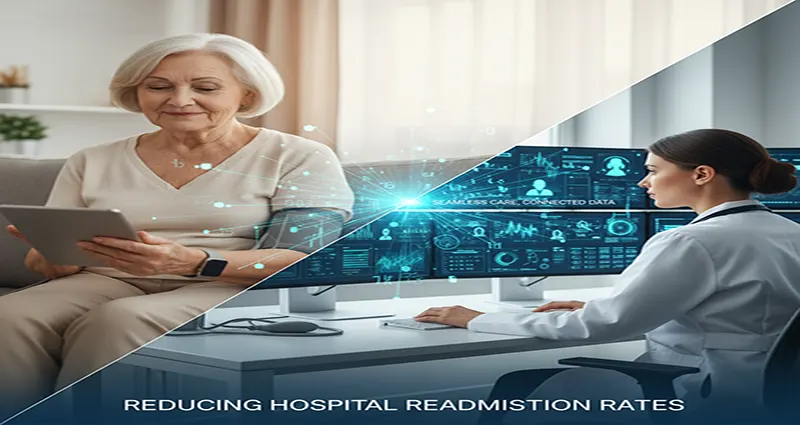Hospital readmissions—when a patient is re-admitted to the hospital shortly after being discharged—represent a significant quality-of-care challenge and a substantial financial burden on healthcare systems. Unplanned re-hospitalizations, particularly within 30 days of discharge, often signal a breakdown in post-discharge care. Remote Patient Monitoring (RPM) is emerging as a powerful, data-driven solution, actively bridging the gap between hospital and home care and demonstrating significant success in keeping patients healthy and out of the hospital.
How RPM Intervenes to Prevent Readmissions
Remote Patient Monitoring utilizes technology to allow healthcare providers to track a patient’s physiological data and other health metrics from a distance, typically after they return home from a hospital stay. This continuous, real-time connection fundamentally changes post-discharge management from a reactive to a proactive care model.
1. Early Detection of Deterioration
The most critical function of RPM in preventing readmissions is its ability to provide real-time health data. Patients with chronic conditions, such as Heart Failure (HF), Chronic Obstructive Pulmonary Disease (COPD), and diabetes, are often at high risk for readmission. RPM devices—like connected blood pressure cuffs, digital scales, glucose meters, and pulse oximeters—monitor vital signs and key metrics.
- If a patient with heart failure gains excessive weight, a potential sign of fluid retention, the RPM system immediately alerts the care team.
- If a COPD patient’s oxygen saturation drops, an alert is triggered.
This early warning system allows clinicians to intervene before a small decline escalates into an emergency requiring readmission. Interventions may include a quick medication adjustment, a virtual consultation, or a nurse home visit, resolving the issue safely outside the hospital setting.
2. Enhanced Patient Engagement and Adherence
A major factor in readmissions is poor adherence to medication and treatment plans at home. RPM systems are designed to be user-friendly, actively involving patients in their care journey.
- Empowerment: Patients are provided with tools and data about their own health, making them more aware of their condition and encouraging self-management.
- Support: Devices often include medication reminders, educational content, and a direct line for communication with their care team.
This enhanced engagement leads to greater patient compliance, ensuring they stick to their prescribed regimen and lifestyle changes, which is crucial for long-term recovery and stability.
The Evidence: Quantifiable Reduction in Readmission Rates
A growing body of research confirms RPM’s effectiveness in reducing acute care use. Studies focused on high-risk populations have yielded compelling results:
- Heart Failure: Multiple studies show that RPM programs for heart failure patients can lead to significant reductions in 30-day hospital readmissions, with some reports citing reductions of up to 50% or more.
- COPD: Similarly, RPM has been found to be highly effective in reducing hospital visits and emergency department presentations for patients managing COPD.
- Value-Based Care: For healthcare organizations participating in value-based care models, which penalize hospitals for high readmission rates (like the Hospital Readmissions Reduction Program in the US), RPM serves as an indispensable strategy to improve quality metrics and maintain financial sustainability.
In a comprehensive view, the effectiveness varies across conditions, but the consistent theme is that targeted RPM for high-risk patients with chronic conditions, especially Cardiovascular Disease and COPD, provides a tangible benefit in reducing hospital admissions and lengths of stay.
Overcoming Implementation Challenges
While the benefits are clear, the successful implementation of an RPM program hinges on addressing several key challenges:
| Challenge | Mitigation Strategy |
| Data Overload | Implement sophisticated RPM software with automated triage and smart alerts to help care teams prioritize the highest-risk patients. |
| Digital Divide/Literacy | Provide comprehensive training, technical support, and user-friendly devices specifically designed for the target patient population, especially the elderly. |
| Workflow Integration | Integrate RPM data and alerts directly into the Electronic Health Record (EHR) to streamline clinical workflows for nurses and physicians. |
By strategically selecting the right technology, ensuring robust patient education, and integrating the program into the existing clinical workflow, healthcare providers can maximize RPM’s potential to deliver high-quality, continuous care at home.
Remote Patient Monitoring is transforming post-discharge care, providing the necessary link between the hospital and the patient’s home. By enabling early, timely interventions based on continuous, objective data, and fostering proactive patient engagement, RPM is proving to be a highly effective and financially viable tool for healthcare systems committed to reducing costly and preventable hospital readmissions, ultimately leading to better health outcomes and a higher quality of life for patients.











